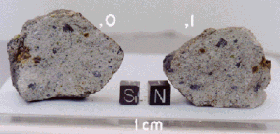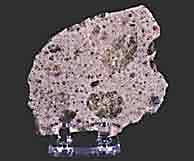
Sayh al Uhaymir 169 is a 206 grams lunar meteorite found in the Sayh al Uhaymir region of the Sultanate of Oman in January 2002.

The geology of the Moon is quite different from that of Earth. The Moon lacks a significant atmosphere, which eliminates erosion due to weather; it does not have any form of plate tectonics, it has a lower gravity, and because of its small size, it cooled more rapidly. The complex geomorphology of the lunar surface has been formed by a combination of processes, especially impact cratering and volcanism. The Moon is a differentiated body, with a crust, mantle, and core.
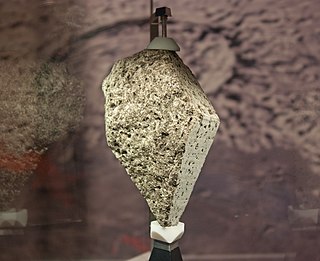
Moon rock or lunar rock is rock that is found on the Earth's moon including lunar material collected during the course of human exploration of the Moon, or rock that has been ejected naturally from the Moon's surface.
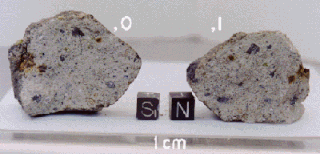
HED meteorites are a clan (subgroup) of achondrite meteorites. HED stands for "howardite–eucrite–diogenite". These achondrites came from a differentiated parent body and experienced extensive igneous processing not much different from the magmatic rocks found on Earth and for this reason they closely resemble terrestrial igneous rocks.
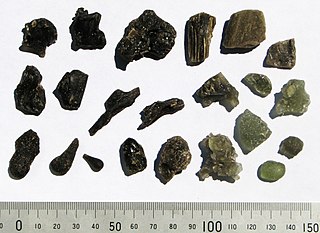
Darwin glass is a natural glass found south of Queenstown in West Coast, Tasmania. It takes its name from Mount Darwin in the West Coast Range, where it was first reported, and later gave its name to Darwin Crater, a probable impact crater, and the inferred source of the glass.

Mesosiderites are a class of stony–iron meteorites consisting of about equal parts of metallic nickel-iron and silicate. They are breccias with an irregular texture; silicates and metal occur often in lumps or pebbles as well as in fine-grained intergrowths. The silicate part contains olivine, pyroxenes, and Ca-rich feldspar and is similar in composition to eucrites and diogenites.
Yamato 791197, official abbreviation Y-791197, is a meteorite that was found in Antarctica on November 20, 1979.
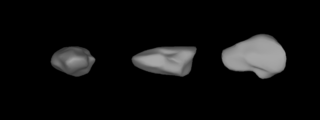
3103 Eger is an Apollo and Mars-crosser asteroid that was discovered in 1982, by Miklós Lovas. It was named after the city of Eger, Hungary. It has an albedo of 0.64, making it a highly reflective asteroid.
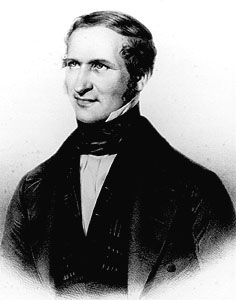
Prof Gustavus ("Gustav") Rose FRSFor HFRSE was a German mineralogist who was a native of Berlin. He was President of the German Geological Society from 1863 to 1873.
This is a glossary of terms used in meteoritics, the science of meteorites.

Northwest Africa 7034 is a Martian meteorite believed to be the second oldest yet discovered. It is estimated to be two billion years old and contains the most water of any Martian meteorite found on earth. Although it is from Mars it does not fit into any of the three SNC meteorite categories, and forms a new Martian meteorite group named "Martian ". Nicknamed "Black Beauty", it was purchased in Morocco and a slice of it was donated to the University of New Mexico by its American owner.
Bunburra Rockhole is an anomalous basaltic achondritic meteorite. Originally classified as a eucrite, it was thought to belong to a group of meteorites that originated from the asteroid 4 Vesta, but has since been reclassified based on oxygen and chromium isotopic compositions. It was observed to fall on July 21, 2007, 04:43:56 local time, by the Desert Fireball Network (DFN). Two fragments weighing 150g and 174g were recovered by the DFN at 31°21.0′S, 129°11.4′E in the Nullarbor Desert region, South Australia in November of the same year. This is the first meteorite to be recovered using the Desert Fireball Network observatory.
Jodzie is a meteorite that fell on 17 June 1877 near the village of Juodžiai near Panevėžys. It is a relatively rare howardite with some carbonaceous inclusions that were likely a result of an asteroid collision. Therefore, despite its small size, it has been a subject of several scientific studies.
Padvarninkai meteorite is a meteorite that fell on 9 February 1929 near the village of Padvarninkai located near Andrioniškis, Anykščiai District Municipality, Lithuania. It is a rare eucrite that contains maskelynite and is highly shocked.



